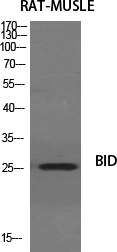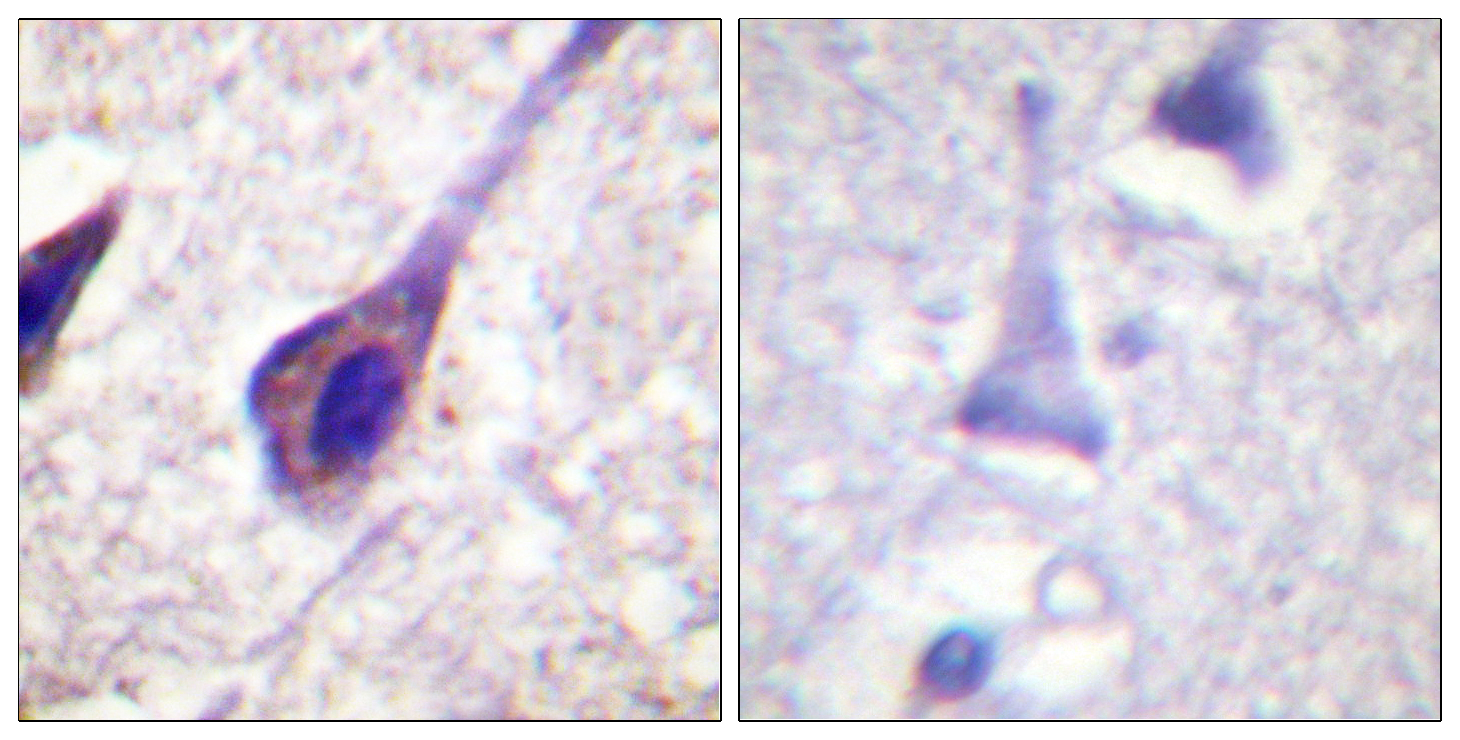BID Polyclonal Antibody
- Catalog No.:YT0488
- Applications:WB;IHC;IF;ELISA
- Reactivity:Human;Rat;Mouse;
- Target:
- BID
- Fields:
- >>Platinum drug resistance;>>Sphingolipid signaling pathway;>>p53 signaling pathway;>>Apoptosis;>>Apoptosis - multiple species;>>Necroptosis;>>Natural killer cell mediated cytotoxicity;>>Non-alcoholic fatty liver disease;>>Alzheimer disease;>>Amyotrophic lateral sclerosis;>>Pathways of neurodegeneration - multiple diseases;>>Tuberculosis;>>Hepatitis C;>>Hepatitis B;>>Measles;>>Human cytomegalovirus infection;>>Influenza A;>>Kaposi sarcoma-associated herpesvirus infection;>>Herpes simplex virus 1 infection;>>Epstein-Barr virus infection;>>Human immunodeficiency virus 1 infection;>>Pathways in cancer;>>Viral myocarditis;>>Lipid and atherosclerosis
- Gene Name:
- BID
- Protein Name:
- BH3-interacting domain death agonist
- Human Gene Id:
- 637
- Human Swiss Prot No:
- P55957
- Mouse Gene Id:
- 12122
- Mouse Swiss Prot No:
- P70444
- Immunogen:
- The antiserum was produced against synthesized peptide derived from human BID. AA range:44-93
- Specificity:
- BID Polyclonal Antibody detects endogenous levels of BID protein.
- Formulation:
- Liquid in PBS containing 50% glycerol, 0.5% BSA and 0.02% sodium azide.
- Source:
- Polyclonal, Rabbit,IgG
- Dilution:
- WB 1:500 - 1:2000. IHC 1:100 - 1:300. ELISA: 1:10000.. IF 1:50-200
- Purification:
- The antibody was affinity-purified from rabbit antiserum by affinity-chromatography using epitope-specific immunogen.
- Concentration:
- 1 mg/ml
- Storage Stability:
- -15°C to -25°C/1 year(Do not lower than -25°C)
- Other Name:
- BID;BH3-interacting domain death agonist;p22 BID;BID
- Observed Band(KD):
- 25kD
- Background:
- This gene encodes a death agonist that heterodimerizes with either agonist BAX or antagonist BCL2. The encoded protein is a member of the BCL-2 family of cell death regulators. It is a mediator of mitochondrial damage induced by caspase-8 (CASP8); CASP8 cleaves this encoded protein, and the COOH-terminal part translocates to mitochondria where it triggers cytochrome c release. Multiple alternatively spliced transcript variants have been found, but the full-length nature of some variants has not been defined. [provided by RefSeq, Jul 2008],
- Function:
- domain:Intact BH3 motif is required by BIK, BID, BAK, BAD and BAX for their pro-apoptotic activity and for their interaction with anti-apoptotic members of the Bcl-2 family.,function:The major proteolytic product p15 BID allows the release of cytochrome c (By similarity). Isoform 1, isoform 2 and isoform 4 induce ICE-like proteases and apoptosis. Isoform 3 does not induce apoptosis. Counters the protective effect of Bcl-2.,PTM:Phosphorylated upon DNA damage, probably by ATM or ATR.,PTM:TNF-alpha induces a caspase-mediated cleavage of p22 BID into a major p15 and minor p13 and p11 products.,subcellular location:A significant proportion of isoform 2 localizes to mitochondria, it may be cleaved constitutively.,subcellular location:Associated with the mitochondrial membrane.,subcellular location:Translocates to mitochondria as an integral membrane protein.,subcellular location:When uncleaved
- Subcellular Location:
- Cytoplasm . Mitochondrion membrane . Mitochondrion outer membrane . When uncleaved, it is predominantly cytoplasmic. .; [BH3-interacting domain death agonist p15]: Mitochondrion membrane . Translocates to mitochondria as an integral membrane protein. .; [BH3-interacting domain death agonist p13]: Mitochondrion membrane . Associated with the mitochondrial membrane. .; [Isoform 1]: Cytoplasm .; [Isoform 3]: Cytoplasm .; [Isoform 2]: Mitochondrion membrane . A significant proportion of isoform 2 localizes to mitochondria, it may be cleaved constitutively. .
- Expression:
- [Isoform 2]: Expressed in spleen, pancreas and placenta (at protein level). ; [Isoform 3]: Expressed in lung, pancreas and spleen (at protein level). ; [Isoform 4]: Expressed in lung and pancreas (at protein level).
SPAG6 regulates cell apoptosis through the TRAIL signal pathway in myelodysplastic syndromes. ONCOLOGY REPORTS 2017 Mar 31 WB Human 1:500 SKM-1 cell
Voacamine is a novel inhibitor of EGFR exerting oncogenic activity against colorectal cancer through the mitochondrial pathway PHARMACOLOGICAL RESEARCH Sanjun Shi WB Human,Mouse
Cathepsin B mediates the lysosomal-mitochondrial apoptosis pathway in arsenic-induced microglial cell injury. Baofei Sun IF,WB Mouse 1:200,1:800 BV2 cell
Delivery of 5-fluorouracil for cancer therapy using aptamer-based nonlinear hybridization chain reaction INTERNATIONAL JOURNAL OF PHARMACEUTICS Haofei Ji WB Human HepG-2 cell
- June 19-2018
- WESTERN IMMUNOBLOTTING PROTOCOL
- June 19-2018
- IMMUNOHISTOCHEMISTRY-PARAFFIN PROTOCOL
- June 19-2018
- IMMUNOFLUORESCENCE PROTOCOL
- September 08-2020
- FLOW-CYTOMEYRT-PROTOCOL
- May 20-2022
- Cell-Based ELISA│解您多样本WB检测之困扰
- July 13-2018
- CELL-BASED-ELISA-PROTOCOL-FOR-ACETYL-PROTEIN
- July 13-2018
- CELL-BASED-ELISA-PROTOCOL-FOR-PHOSPHO-PROTEIN
- July 13-2018
- Antibody-FAQs
- Products Images

- Western Blot analysis of various cells using BID Polyclonal Antibody diluted at 1:1000
.jpg)
- Western Blot analysis of Jurkat cells using BID Polyclonal Antibody diluted at 1:1000

- Immunohistochemistry analysis of paraffin-embedded human brain, using BID Antibody. The picture on the right is blocked with the synthesized peptide.

- Western blot analysis of lysates from Jurkat cells treated with H2O2 100uM 30', using BID Antibody. The lane on the right is blocked with the synthesized peptide.



